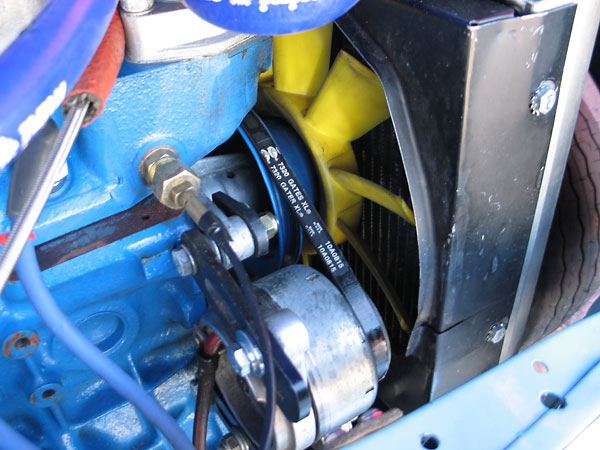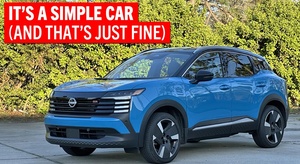I'm currently running NO charging system in my vintage race-Spridget. And it's fine. Simple and manually recharging at the track isn't a big deal.
But I'm building a second racer. And I've been intrigued by these mini-alternators I see on Kubota tractors. They are permanent magnet and very light weight. Output is only 14 amps, but that's fine for what I would need.
I've had people tell me they work fine. And I've had other people say the permanent magnet design is bad because it's primitive and requires a high heat-generating "Rectifier/Regulator" to bleed off excess voltage.
They weight about 3.5 lbs and are tiny. Cost is about $110 with another $60 for the Rectifier/Regulator. You can see them for sale HERE
I've run a 30 amp internally regulated Mitsubishi car alternator in the past (and I still have it). Works fine but is bigger.
Any opinions about these mini-alternators?
Here's a shot of one in a Mini:

My Father has them on his Kubota tractor and zero turn mower. He's never had a charging problem. One thing to consider is the Kubota engines only turn about 2500 rpms, keep that in mind when choosing an engine pulley.
call me interested. I found the Denso 5lb alternators, but the original Bosch that was installed on my GTV wasn't all that heavy- and the denso was more of a fabrication exercise.
That weight, though. If it can handle the revs you will be spinning, that will be interesting. What kind of pully size do you intend to use? And what kind of revs are you planning on turning? My main pully is not really adjustable, since it runs a fuel injection pump, but w/o that, I can go with a smaller pully from an earlier engine. Other than that, I'm stuck with the pully, and my car is intended to spin at about 7000-7500rpm max. So as long as the alternator can take it, it would be a great option.
I have a Denso on my Camaro, part #8162, see here: http://www.powermastermotorsports.com/denso_alternators.html
It is a one-wire so hookup is easy and while it says it is 50 amp, the dyno test tag with mine has it putting out 61 amps with voltage set at 14.9 volts. It isn't the cheapest out there, but there are other options in the link as well.

This car with a Chevy 350 was running an alternator off a golf cart and it drove a bit over 100 miles to the show.
If I were to run the Kubota alternator, I'd swap to a bigger pulley to bring RPMs down. I have access to a full machine shop so no big deal.
Conquest351 wrote:
Check out Racemate...
http://racemate.com/
Really like the Racemate unit (and especially since it can have a variety of puleys).......but it basically looks like the Kubota unit (and has similar output), but probably a lot more money.
Sea doo rotax 2- strokes turn 7k and use a similar setup, but the coils are right on the front of the crankcase. They put out a similar 14ish amps.
I don't know how good you are at fabbing, but something you might consider is using the stator and magnets off a sportbike direct mounted on the crank of your race motor. Those turn ~11-14K RPM without failure all the time. The cheap Chrysler external voltage regulator can be used.

EvanR
Reader
6/14/12 6:23 p.m.

Carbureted Chevy Sprint alternator is tiny, 45 amps is plenty, and, well, it's for a car.

Nashco
UltraDork
6/14/12 8:06 p.m.
Curmudgeon wrote:
I don't know how good you are at fabbing, but something you might consider is using the stator and magnets off a sportbike direct mounted on the crank of your race motor. Those turn ~11-14K RPM without failure all the time. The cheap Chrysler external voltage regulator can be used.
I was thinking the same thing! You'd also be able to ditch the belt drive, which would be totally sweet. I'd really like to try this on one or three of my project cars. I just need to find a bike that has a charging system with enough powah for my project car (I'm thinking touring bikes might be a better bet for lower RPM and higher current).
Bryce
Some great idea and food for thought.
One of my real questions (and sorry if I wasn't clear about this) was the notion that little permanent magnet alternators are very inefficient.
A poster on another forum said that since the field strength is unregulated, these mini-alternators generate excess electricity and simply "bleed off" extra current in the form of heat (thought the "regulator").
He implied that they are a much bigger parasitic drag on the engine than a regular alternator.
Any thoughts? I'm not sure myself.
Inefficent yes. Greater drag than a regular alternator sorta. Greater drag than a regular alternator that puts out the same ampacity yes, but how many standard alternators put out 14a?
I'm using an alternator from a John Deere Gator. Just a hair under 7lbs and it has a built in regulator. It puts out 30a which is overkill on the Europa but it fits in the very limited space I have.
That Chevy Sprint alt pictured above looks a lot like the one I picked off a Geo Metro at the pick-n-pull for my race car. It's a 1 wire, 3lb 45 amp unit that cost $20 from Harry's. I have not gotten around to fabbing a bracket yet but I imagine it does just fine.

Don49
Reader
6/15/12 10:30 a.m.
Lots of roadracers are using the Sprint/Geo alternator. It works great and is a very compact package.
Being permanent magnet won't the alternator the OP is asking about always be a constant load on the engine?
I think a standard alt wouldn't rob as much horsepower but the tiny one would weigh less.
I CAD'ed up and CNC'ed out a bunch of mounts for the Denso alternators for fiat 600 and 850 motors thinking that the owners of these cars would tire of complaining about their charging systems and leap at the opportunity to inexpensively fix them but the response was pretty much nil

At least the racers like them.

Nashco
UltraDork
6/15/12 2:39 p.m.
ditchdigger wrote:
I CAD'ed up and CNC'ed out a bunch of mounts for the Denso alternators for fiat 600 and 850 motors thinking that the owners of these cars would tire of complaining about their charging systems and leap at the opportunity to inexpensively fix them but the response was pretty much nil
Just curious, why the cogged drive belt instead of a V or multi-rib? Those pulleys look 'spensive.
Bryce
Nashco wrote:
Just curious, why the cogged drive belt instead of a V or multi-rib? Those pulleys look 'spensive.
Bryce
No idea why. Not my motor. I was handed the cog belt setup and told to make it work. I had to machine the crank nut out of hex stock, make a new center for the alternator pulley and machine the backs of all the pulleys to get them to line up.
Looks friggin awesome though! The owner/builder is a pretty amazing guy.
His company http://www.vintageunderground.us/
His other company http://www.sportscarshop.com/
His blog http://joepottersvintageground.blogspot.com/
I try to stay on his good side and make sure that whatever he wants he gets.
The PMA's big advantage: no brushes. It requires no battery 'exciter' voltage to get it going, that's a big deal when you have a low battery and are trying to get it fired up. Some of the sportbikes have reasonably high outputs, around 50-60 amps. For that matter, there's no reason it couldn't be run off of a water pump like that megabux Racemate setup.
PMA = generator.
An alternator's output is regulated by controlling the current in the field coil.
With a PMA, you can accomplish the same thing by Pulse Width Modulating the output.
But as stated, efficiency will be somewhat lower.
OTOH, who give as a flying f@%k about efficiency?

JS154
New Reader
12/7/17 3:47 p.m.
I tired running a Bosch motorsport alternator a few years ago in the GULF M3 Super Touring car. I don't recall which one, but we had to fab up custom mounts, it weighed only a few pounds, it put out plenty of power and it failed on the third session. Sold as a race part, so no warrantee. Put a second one one. Failed immediately on track.
SO my experience with Bosch lightweight racing alternators are: utter junk.
We put the stock used 90K mile street Bosch alternator back in and it has run flawlessly since then, and that was like 4 years ago. For the extra 8 or 10 pounds, I'll take 100% reliability thanks.











































